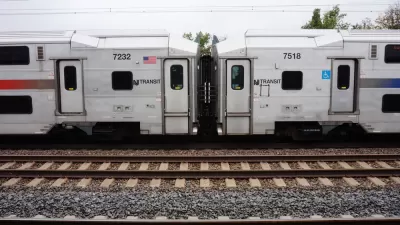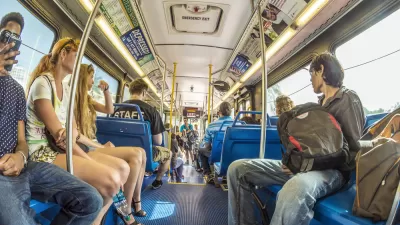U.S. commuter rail systems, primarily designed to bring workers to and from central business districts, must adapt to serve a broader population as the traditional workday changes.

"The future of America’s commuter rail model, including its heavy staff levels, is in doubt because of COVID-19," writes Jake Blumgart in Governing. "U.S. regional rail systems," which "have long been oriented toward suburban white-collar commuters," suffered massive revenue losses as commuting slowed to a trickle. "In the long term, it is projected that remote work will remain much more common, even after the pandemic eases. That means the core demographic for commuter rail could either continue to work from home or only come into the office a few days per week."
To adapt, commuter rail systems have started adding more frequent non-peak hour service and greater frequencies, but agencies are hindered by high labor and infrastructure costs. "One of the biggest is inefficiently allocated labor costs. American commuter rail systems operate on an antiquated model, employing not just engineers who drive the train but multiple conductors who punch tickets and help passengers on from platforms that are (in many cases) much lower than the train doors. For example, the staffing levels on the Berlin S-Bahn, the German capital city’s regional rail network, are about one-third the size of the Long Island Rail Road (America’s busiest commuter rail system), which in turn serves only about a third of the passengers." Other problems include the "antiquated practices" such as inefficient diesel locomotives, "low-level platforms that don’t allow for easy boarding," and a much higher per-kilometer cost than European rail systems.
"But advocates of enhanced service argue that these infrastructural challenges are not as big as transit agencies are claiming. In an era when the federal government has been providing unprecedented support to mass transit and Congress is debating the largest infrastructure spending initiative in modern memory, there may be fiscal room to maneuver."
FULL STORY: Commuter Rail Reform Faces High Labor, Infrastructure Costs

Alabama: Trump Terminates Settlements for Black Communities Harmed By Raw Sewage
Trump deemed the landmark civil rights agreement “illegal DEI and environmental justice policy.”

Planetizen Federal Action Tracker
A weekly monitor of how Trump’s orders and actions are impacting planners and planning in America.

The 120 Year Old Tiny Home Villages That Sheltered San Francisco’s Earthquake Refugees
More than a century ago, San Francisco mobilized to house thousands of residents displaced by the 1906 earthquake. Could their strategy offer a model for the present?

In Both Crashes and Crime, Public Transportation is Far Safer than Driving
Contrary to popular assumptions, public transportation has far lower crash and crime rates than automobile travel. For safer communities, improve and encourage transit travel.

Report: Zoning Reforms Should Complement Nashville’s Ambitious Transit Plan
Without reform, restrictive zoning codes will limit the impact of the city’s planned transit expansion and could exclude some of the residents who depend on transit the most.

Judge Orders Release of Frozen IRA, IIJA Funding
The decision is a victory for environmental groups who charged that freezing funds for critical infrastructure and disaster response programs caused “real and irreparable harm” to communities.
Urban Design for Planners 1: Software Tools
This six-course series explores essential urban design concepts using open source software and equips planners with the tools they need to participate fully in the urban design process.
Planning for Universal Design
Learn the tools for implementing Universal Design in planning regulations.
Clanton & Associates, Inc.
Jessamine County Fiscal Court
Institute for Housing and Urban Development Studies (IHS)
City of Grandview
Harvard GSD Executive Education
Toledo-Lucas County Plan Commissions
Salt Lake City
NYU Wagner Graduate School of Public Service





























